ARM Cortex A12: Between Cortex A9 and A15 in Power & Perf, Sampling in Late 2014
by Anand Lal Shimpi on June 2, 2013 11:31 PM EST- Posted in
- Smartphones
- CPUs
- Arm
- Mobile
- Tablets
- Trade Shows
- SoCs
- Cortex A12
- Computex 2013
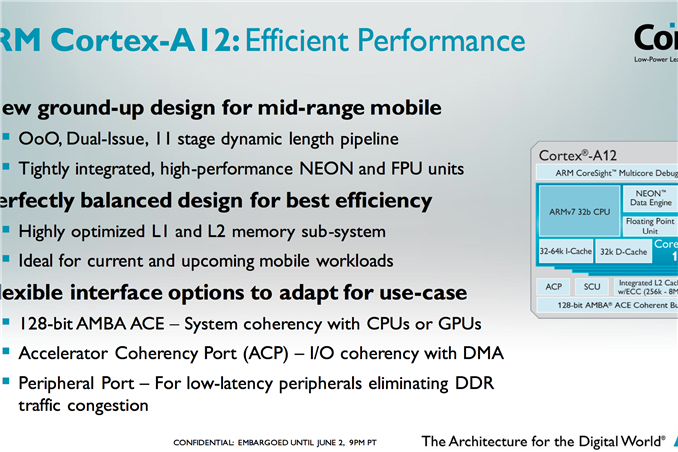
We’ve talked about the hole in ARM’s product lineup for quite a while now. The Cortex A9 is too slow to compete with the likes of Intel’s Atom and Qualcomm’s Krait 200/300 based SoCs. The Cortex A15 on the other hand outperforms both of those solutions, but at considerably higher power and die area requirements. The slide below from Samsung illustrates my point clearly:
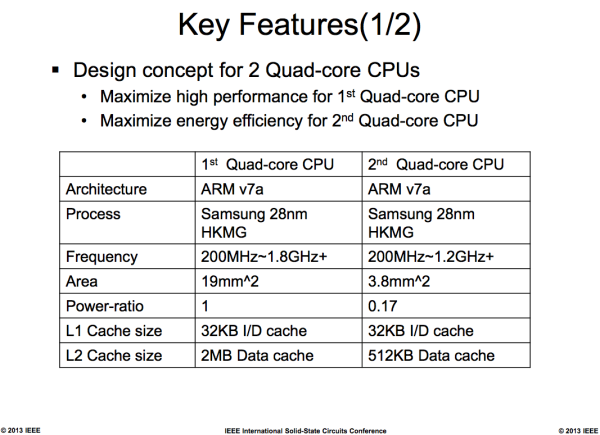
The comparison point here is the Cortex A15 and Cortex A7, but the latter should be quite performance competitive with a Cortex A9 so the comparison is still relevant. The Cortex A15 island in Samsung’s Exynos 5 Octa occupies 5x the die area as the A7 island, and consumes nearly 6x the power. In exchange for 5x the area and 6x the performance, the Cortex A15 offers under 4x the performance. It’s not exactly an area or power efficient solution, but a great option for anyone looking to push the performance envelope.
Today, ARM is addressing that hole with the Cortex A12.
This announcement isn’t a deep architectural disclosure, but we do have some high level details to share. Like AMD’s Jaguar, Intel’s Silvermont and even ARM’s A9, the Cortex A12 is a dual-issue out-of-order architecture. Unlike the Cortex A9, the Cortex A12 is fully out-of-order including the NEON/FP units (NEON/FP was in-order on Cortex A9).
Pipeline length increased a bit compared to Cortex A9 (11 stages), however ARM told me to expect similar frequencies to what we have with the Cortex A9.
The execution back end has also been improved, although I don’t have many details as to how. My guess is we should expect something a bit wider than Cortex A9 but not nearly as wide as Cortex A15.
Memory performance is much improved compared to Cortex A9 as well, which we’ve already demonstrated as a significant weak point in the A9 architecture.
All of the architectural enhancements are supposed to provide up to a 40% increase in performance (IPC) over Cortex A9 at the same frequency and process node. ARM isn’t talking power, other than to say that it can do the same workload at the same power as a Cortex A9. In order words, Cortex A12 should have higher power than Cortex A9 but faster execution reduces total energy consumed. With a higher max power we’ll see more dynamic range in power consumption, but just not nearly as much as with the Cortex A15.
Cortex A12 also adds support for 40-bit memory addressability, an intermediate solution before we get to 64-bit ARMv8 based architectures. Finally, Cortex A12 features the same ACE bus interface as Cortex A7/A15 and can thus be used in big.LITTLE configurations with either core (but likely exclusively with the A7s). Given the lower power profile of Cortex A12, I'm not sure the complexity of doing a big.LITTLE implementation will be worth it though.
ARM expects the Cortex A12 to be used in mainstream smartphones and tablets where cost and power consumption are a bit more important. The design makes a lot of sense, the only downside is its launch timeframe. ARM expects to be sampling Cortex A12 in late 2014 with the first devices showing up in 2015. Update: ARM clarified that SoCs based on Cortex A12 would be shipping to device vendors in mid-2014, with devices shipping to consumers by late 2014 to early 2015. ARM has optimized Cortex A12 processor packs at both Global Foundries (28nm SLP) and TSMC (28nm HPM).


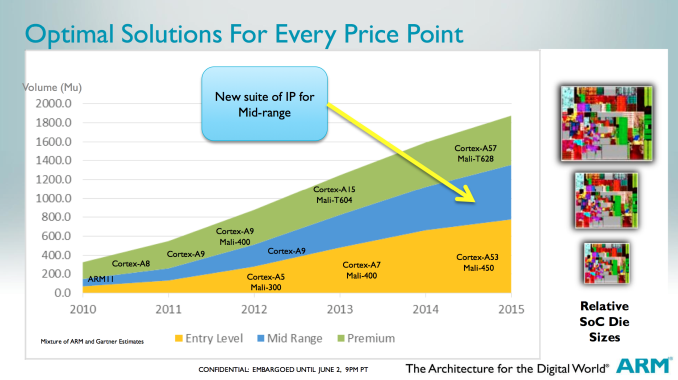
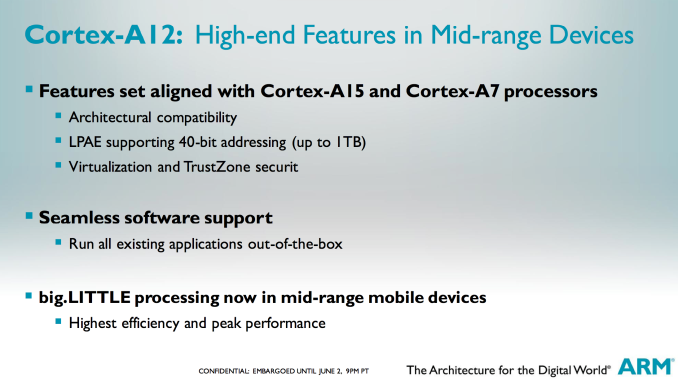
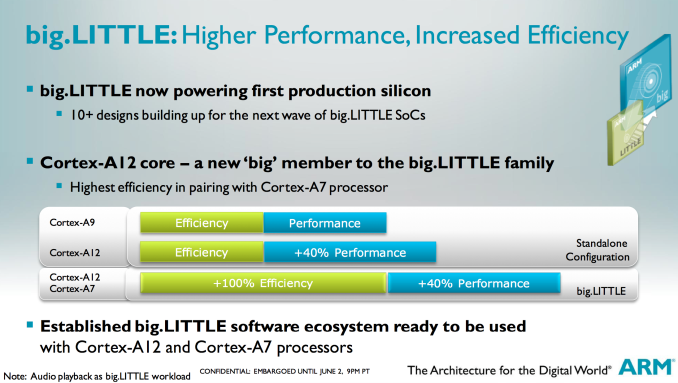








78 Comments
View All Comments
Wilco1 - Monday, June 3, 2013 - link
Ah you're right, K900 results just appeared - still terrible vs S4: http://browser.primatelabs.com/geekbench2/compare/...Krysto - Tuesday, June 4, 2013 - link
What are you talking about? Old Atom is not even CLOSE to A15 in performance. At the same clock speed, A15 has at least 50% performance advantage.wsw1982 - Monday, June 3, 2013 - link
The A12 sounds really the same as the Qualcomm Krait and Apple swift, up to 40% faster with the same power consumption. I have no ideal why ARM introduce it, as it's 2 years late than the counterparts form Qualcomm and Apple and targeting the same market. And as for the Atom, the current generation Atom (5 years old architecture)is already comparable to Krait, swift and A15 in performance/watt with 32nm technology.To me, ARM armed too high with A15 which was simply not designed for phone/tablet. Keep in mind, the A15 without throttling is a 8w monster comparing to 2+w socs for either tablet or smart phones. ARM were either too confident about A9, or mislead by Intel's MID concepts. In either case, the A12 sounds like a making-up of their wrong decision, just a reinvent-the-wheel of the Krait and Swift. Is this the reason cost their CEO?
Wilco1 - Monday, June 3, 2013 - link
A12 is effectively an improved A9, and quite different from Krait and Swift which are far more similar to A15. Note that A15/Krait/Swift are a lot faster than A9, while A7 is quite close in performance despite using less power. So A9 is no longer competitive, and the A12 will take over the mid range. It would have been better for it to arrive earlier indeed, but there are only so many OoO CPUs one can design per year...The Korean Galaxy S4 uses an Exynos Octa which consumes 5.5W at 1.8GHz. That is fine for mobiles and tablets, for example power is similar as Tegra 3 despite providing more than twice the performance. For typical usage you rarely need that amount of performance, let alone for long periods, so only looking at max TDP is misleading.
What the introduction of yet another new CPU has to do with the CEO is beyond me. The naming of A15 and A9 suggests the mid-range A12 was planned a long time ago (Cortex numbering indicates relative performance).
tech4real - Monday, June 3, 2013 - link
my guess is because A15 on current TSMC/GloF process is seriously overshooting its original power target, and this leaves a huge gap between A15 and A7 for other vendors (apple/qcom/intel) to exploit. What makes matter worse is that the gap happens to sit in the most important power range of high-end smartphone and fanless tablet design points, so ARM has to deliver some stopgap solution.wsw1982 - Monday, June 3, 2013 - link
No, the Krait and Swift are in the same performance range of yet-to-arrive A12 which is at maximum 50% faster than A9. The A15 is another store. It's much faster than both Krait and Swift, but consumes much more power as well. There are review on Nexus 10 which is powered by A15 by Anand. You could check the results. To me, the A15 is fast but not designed for phone or tablet. The only reason could be that the ARM thought the A9 was faster and good enough to secure the Mobile market, and therefore armed the A15 to something bigger (server? MID? netbook?). This caused the trouble now, because apparently the A9 is too weak and the A15 is too power hungry to defense the mobile market, which you can see in the COMPUTEX this year. And therefore, without choice, ARM must introduce yet another core, the A12, to copy the success of krait, swift or even current gen. ATOM. A12 is apparently redesign of the wheel and really has the huge-time-to-the-market (dis)advantage :) This is apparently the decision made by the CEO himself, which put ARM in today's awkward position. It's just the most logic conclusion I could find out. And if my analysis is right, don't you think this bad decision would cost the CEO the job?Wilco1 - Monday, June 3, 2013 - link
By the time A12 comes out, Krait/A15/Swift will be much faster and on 20nm, so the gap between A9 and Krait/A15/Swift will only widen.The issue is that A9 is getting old and no longer competitive, not A15 being too fast or power hungry (A15 will appear in lots of mobiles). In 2014 nobody will use A9 - A7 is as fast and far more efficient (you already see Qualcomm, Allwinner, MediaTek etc using A7 rather than A9 in mid and low-end designs).
As I said before, it's clear A12 has been planned a long time ago, so your analysis is completely incorrect. A12 is not trying to be another Krait or Swift at all (A15 is already faster and A7 is already more efficient), it's simply replacing the old A9.
TheJian - Tuesday, June 4, 2013 - link
Yes, at 20nm the complaints about A15 go away even if you just shrink the same crap and do nothing else but upclock to whatever your power target is for your device. I'm sure everyone will up the gpu some, but this chip seems out of place vs. 20nm everything.Wilco1 - Tuesday, June 4, 2013 - link
A12 is not out of place once you understand that it is an A9 replacement for the mid-end. Currently dual A9 is being replaced with quad Cortex-A7 on 40nm as A7 is far more efficient and cheaper. The next faster core is the A15, which is way too large, power hungry and expensive to use at 40nm. Given that A9 is obsolete there is now a huge gap between A7 and A15, and A12 fits right in there.TheJian - Wednesday, June 5, 2013 - link
You'd better call NV and let them know they're releasing an A9r4 that is obsolete already...ROFL. Just tell them to stop producing T4i and go home. While you're at it tell it to PCmag I just quoted who says it has Top end phone power in a $100-$200 phone.So what does a 20nm die shrink of T4i run at? 2.7-3.0ghz in the same power envelope? Again A12 pointless. They got from 1.7ghz to 2.3ghz from 40 to 28nm. It's reasonable to think even the exact chip at 20nm would hit 2.7ghz at least or your process needs work. Also note this little gem from pcmag article:
http://www.pcmag.com/article2/0,2817,2415515,00.as...
"Unlike Qualcomm, Nvidia isn't actually allowed to design its own ARM-compatible cores, so it had to give the R4 innovations back to ARM and let competitors license them, but the 4i will be the first A9R4 chip on the market."
So everyone will get it eventually, and I'm sure by Q1 2015. T4i has what NV did first with A9R4, but they had to give the improvements back. Note the GPU is not the same, they get to keep all their own tech on that side. But everyone will get the cpu enhancements NV made. I think when A12 hit the drawing board they didn't realize companies like NV would make A9 so much better and in doing so raise everyone else too (who A12 might be aimed at, people who couldn't optimize like NV alone). But with NV having to give it all back, everyone gets it making an A12 redundant at best. T4i die shrunk to 20 puts A12 to shame in the same price and power envelope unless arm starts saying it's die size is 20mm. T4i if half the size of T4 (which is known to be 81mm or so) is 40mm roughly or NV has to measure their own chip again and re-report :) They should know their own T4/T4i die size right? It's amazing they got 72gpu cores on T4 into a 10mm die, so 60gpu cores is obviously smaller. I'd like to know what Arm has to pair with A12 in that size (what 8mm for 60 cores?). Good luck.
http://www.tomshardware.com/reviews/tegra-4-tegra-...
"Nvidia clearly needed to make difficult decisions in order to enable Tegra 4’s GPU in just 10.5 square millimeters of die space—less than Qualcomm’s Adreno 320, ARM’s Mali-T604, or Imagination Technologies’ PowerVR SGX554MP4."
A9R4 is NOT obsolete, and further I'd say dual A9 40nm is being replaced by A9R4 28nm QUAD+1 in a few weeks :) I think they call it a T4i ;) I don't understand your points. Do they sell phones for under $100 without subsidy with power like T4i? Next June/July we'll have T5i no doubt along with everyone else's stuff. A12 doesn't fit well with a 20nm Kepler based T5i and it's ilk. I think most people will want T4i power in $100-200 this year, and whatever T5i brings next year vs. A12. This might have a place if coming next month vs. T4i, not late 2014/Q1 2015.
https://en.wikipedia.org/wiki/Allwinner_A31
Look at the perf in the chart of T3 vs. quad A7. Look at the prices both $20. Look at the raw dmips (12-17 for T3 is bigger than 9.1 for A7quad right?). Gpu better than allwinner also. T4i will make this worse by 5x on gpu and who knows on cpu but it's better. Pixel ability is the only thing better (but that's about dual channel and gpu not cpu). Exynos shows the same. I don't see how this magical A7 quad can be cheaper than a T4i at 1/2 the size of the T3 in the chart going for the EXACT same cost ($20) as the Allwinner A31. Surely T4i is cheaper to make than T3 at 1/2 the die size right? T4 is same size as T3 as toms etc reports. T4i is 1/2 it's size. You're not making any sense. Are you privy to info all of these people don't understand or know? Note they quote that it's partially data we have to believe from allwinner at wikipedia.
"Note: Part of this chart would be AllWinner's opinion which is publicized from the Onda's press conference on December 5, 2012."
So it's only true if you totally believe allwinner. Not saying they're lying, just pointing it out, and I doubt they would undersell themselves so if the numbers are true I again, don't get your points.
Prove A7 quad is cheaper please. Allwinner should know they cost $20, and we already know T3/exynos are basically the same $20 as the chart shows. A few bucks either way is nothing to write home about and T4i is 1/2 the size (I keep repeating this but you don't seem to get this). Worse, A12 will be facing shrinks of everything mentioned.